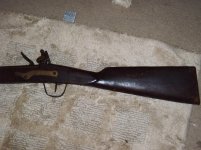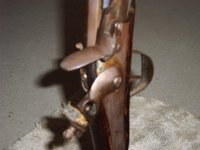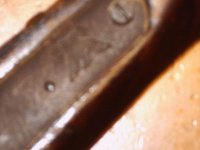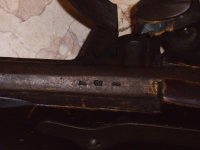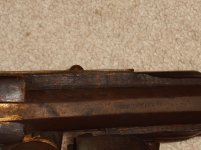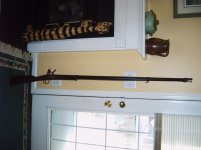You are using an out of date browser. It may not display this or other websites correctly.
You should upgrade or use an alternative browser.
You should upgrade or use an alternative browser.
does anyone know what this old flintlock is
- Thread starter beebrad
- Start date
With all respect, Beebrad, I am sure you are a nice guy, but don't quit your day job to work as a photographer.
From what little I can tell, I think it was made of bits and pieces, probably in some place like the Khyber Pass. The barrel might be from a British musket, part of the lockplate may be U.S., the trigger guard looks handmade, and the marking is the kind of thing put on in places where those funny western characters don't mean anything, so upside down, right side up, sideways, what's the difference.
It might have been made as a serious weapon at the time flintlocks were in use, but I think it was made much more recently to sell as a curio or souvenir. Any idea where it came from? I have heard that since GIs in Afghanistan are not allowed to bring or ship back any modern arms, a few have brought back that kind of thing.
Jim
From what little I can tell, I think it was made of bits and pieces, probably in some place like the Khyber Pass. The barrel might be from a British musket, part of the lockplate may be U.S., the trigger guard looks handmade, and the marking is the kind of thing put on in places where those funny western characters don't mean anything, so upside down, right side up, sideways, what's the difference.
It might have been made as a serious weapon at the time flintlocks were in use, but I think it was made much more recently to sell as a curio or souvenir. Any idea where it came from? I have heard that since GIs in Afghanistan are not allowed to bring or ship back any modern arms, a few have brought back that kind of thing.
Jim
I see the "Made in Belgium" (in English!) now, but it appears to be either stamped over some other marking or overstamped with some other marking. That is why I first assumed it was the usual "Khyber pass" marking using random letter stamps.
The barrel length does not mean that the barrel did not start out as a musket barrel; the eastern craftsmen were adept at welding extra pieces on to the barrel for the reason I mentioned before.
Jim
The barrel length does not mean that the barrel did not start out as a musket barrel; the eastern craftsmen were adept at welding extra pieces on to the barrel for the reason I mentioned before.
Jim

